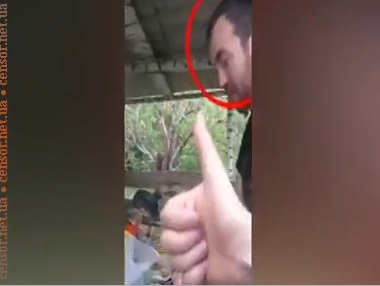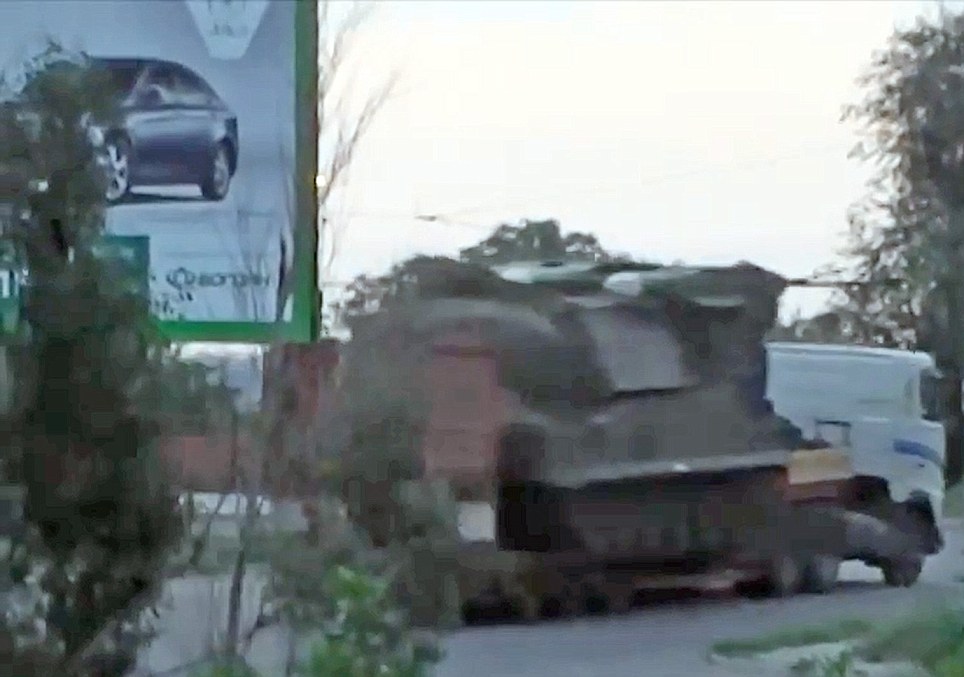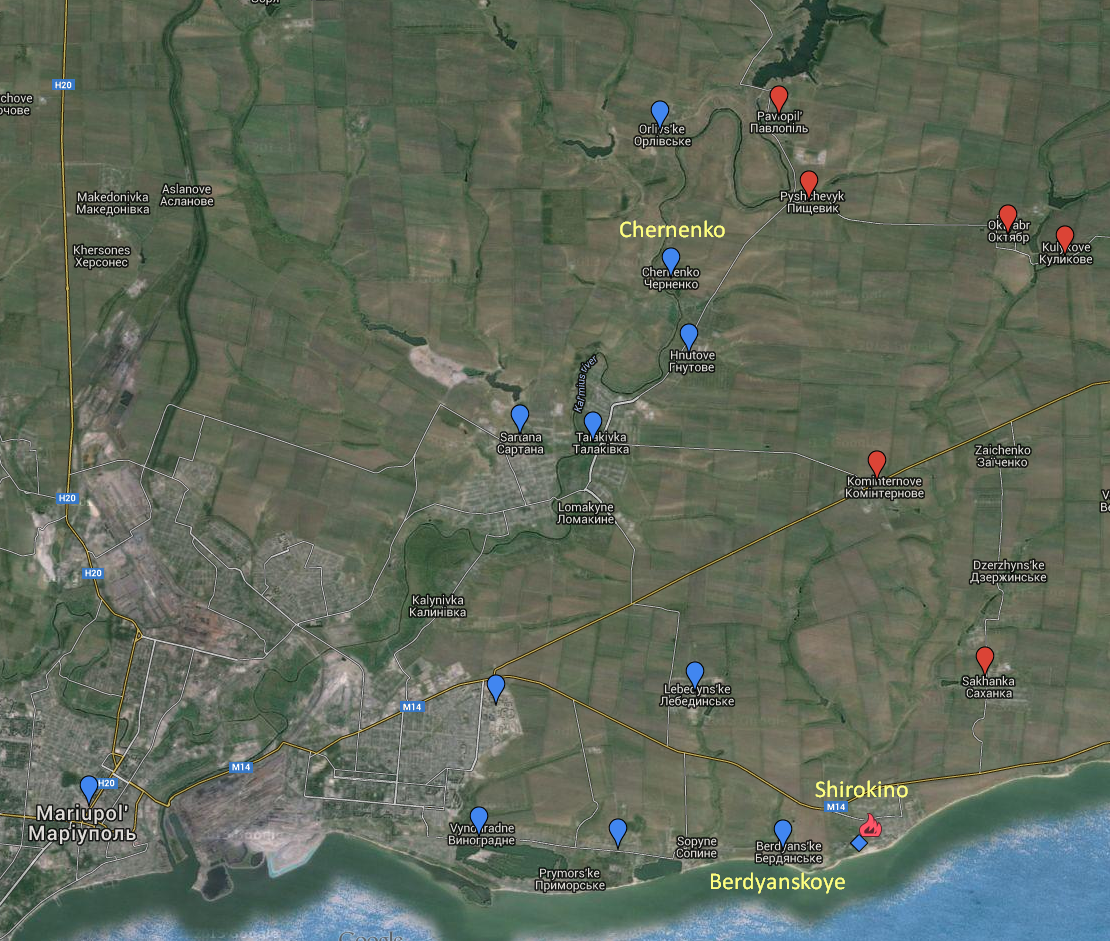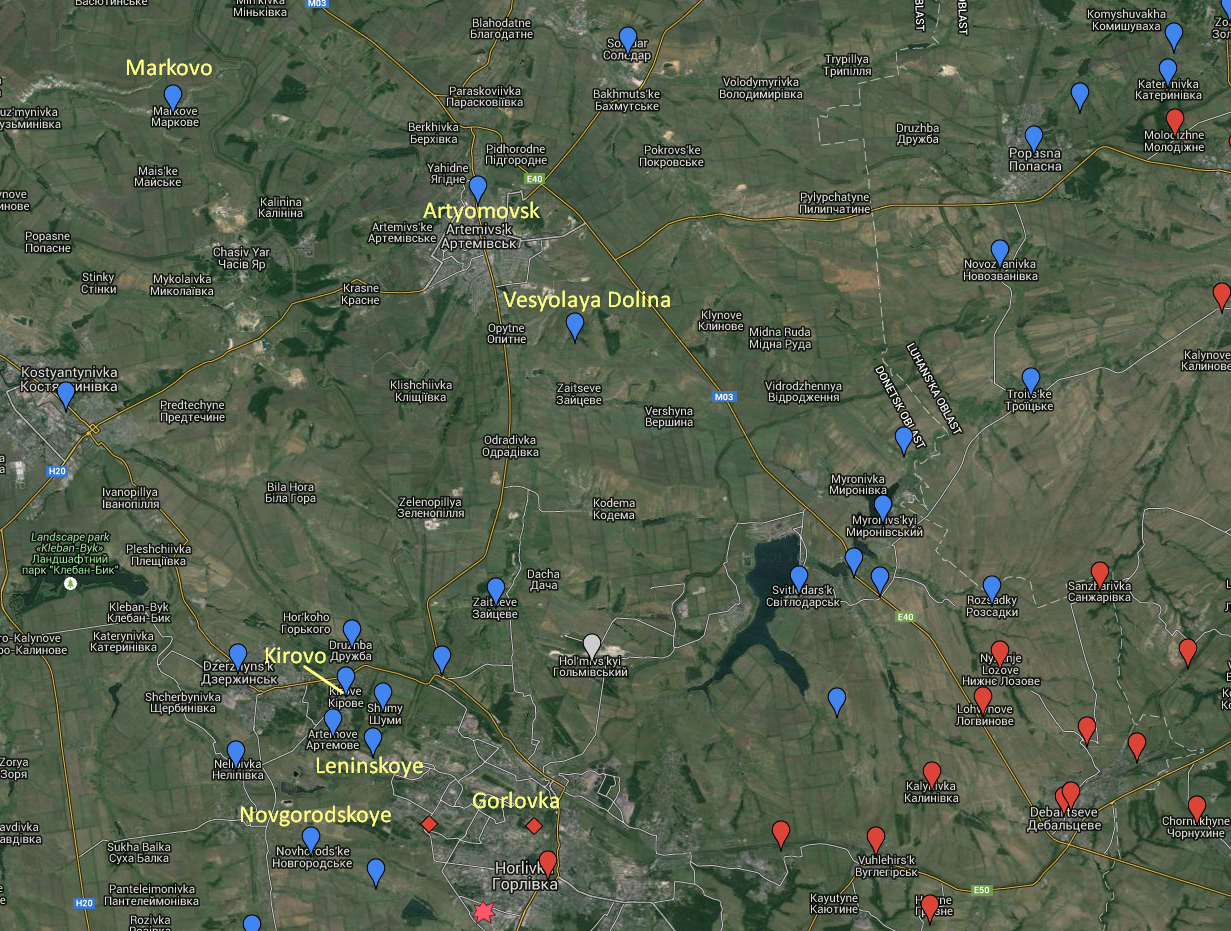Yesterday’s live coverage of the Ukraine conflict can be found here. An archive of our liveblogs can be found here. For an overview and analysis of this developing story see our latest podcast.
Please help The Interpreter to continue providing this valuable information service by making a donation towards our costs.
For links to individual updates click on the timestamps.
For the latest summary of evidence surrounding the shooting down of flight MH17 see our separate article: Evidence Review: Who Shot Down MH17?
The Ukrainian site censor.net has published a video that purports to be from the cell phone of the Russian spetsnaz officer Aleksandr Aleksandrov, who was captured in battle by Ukrainian forces along with another GRU officer, Yevgeny Yerofeyev. They are now in the custody of the Ukrainian Security Service (SBU) which plans to try them as “terrorists.”
The 2.59-minute video shows men in uniform in the bush, which is evidently the GRU reconnaissance group that went into Ukrainian territory. Capt. Yerofeyev can be seen in the video.
It is not clear from the voice if the person taking the video is Aleksandrov himself.
Yuri Lutsenko, head of the Poroshenko Bloc, showed the tape in the Verkhovna Rada, the Ukrainian parliament today, commenting on Russian propaganda “like Goebbels,” denying the Russian military presence in Ukraine.
The first part of the video shows a group of armed fighters in the woods, talking about the shell fire in the distance and the bullets flying over head. The cameraman says he once had to fall on the ground to take cover.
“I totally hugged the Ukrainian soil like my own native [land],” he says.
Rapid gunfire can be heard and the armed fighters talk about RPGs being fired as they find a path to take through the woods.
One of the fighters speaks into a radio to someone with the call-sign “Aggressor.”
Then there’s a break and a second snippet of video showing the fighters in a camp in a mess tent.
“Everything’s under control,” says one voice as they sit eating lunch.
“I’m going to take a machine gun and go into the trenches,” says the cameraman.
Yerofeyev appears at 1:58 cooking something, and the cameraman makes a thumb’s up sign. Yerofeyev asks him if he is filming, and he replies, “Yes.”

There more rapid gunfire nearby, and the cameraman snaps a photo of Yerofeyev.
“You shouldn’t film,” says Yerofeyev. “They’re about to shoot, and you’re filming. What are you doing?
The cameraman says he is filming while the sounds of explosions aren’t so close.
“And now, f**k, the kombat (commander of the battalion) will hear we discussed how to f**k them over,” says Aleksandrov.
“I won’t show it, I’m not capable of showing it,” says the cameraman.
The full version of the video is at Censor.net.
— Catherine A. Fitzpatrick
Besides all of the other evidence — the presence of advanced anti-aircraft weapons which almost certainly belong to the Russian military, the jamming of OSCE drones over separatist territory, and the sheer volume of heavy equipment and tanks operated by the Russian-backed separatists, the OSCE has been quietly publishing important data about the scope of the Russian military involvement in eastern Ukraine.
Once again today we see that play out. Hidden in the latest OSCE report, dated yesterday, June 1, at 19:30 Kiev time, is the revelation that T-72s have been spotted on the move in the self-proclaimed “Donetsk People’s Republic,” or DNR. What the report does not mention, however, is that Ukraine has kept its T-72s in reserve in the west of the country, so these are almost certainly Russian military weapons. Also concerning — the presence of a Main Battle Tanks of an “unknown type on DNR territory. Are these new arrivals, or was the OSCE drone simply unable to make a positive identification?
Despite claims that withdrawal of heavy weapons was complete, the SMM observed 37 tanks, mainly T-72 type, in two concentrations in “DPR”-controlled areas east of Donetsk city and nine tanks, mainly T-72 type, in government-controlled areas north of Donetsk. Furthermore, the SMM observed 10 tanks, mainly T-64 type, in government-controlled areas north-west of Luhansk city.
The SMM unmanned aerial vehicle (UAV) observed a concentration in “DPR”-controlled territory, 61km north-east and 30km east of Mariupol, of at least 10 main battle tanks (MBT) of unknown type.
The OSCE observed continued fighting near Donetsk Airport:
The SMM observed continuing ceasefire violations in and around Donetsk airport (“Donetsk People’s Republic” (“DPR”)-controlled, 12km north-west of Donetsk city centre). During the day, at the Joint Centre for Control and Co-ordination observation point at Donetsk central railway station (“DPR”-controlled, 8km north-west of Donetsk city centre) the SMM heard a total of 109 mainly outgoing explosions from the north, north-north-west and north-east consistent with heavy and light weapons (122mm howitzers, 120 and 82mm mortars), and (23mm) anti-aircraft fire[1].
And near Shirokino:
In line with current security considerations, the SMM did not visit the area of Shyrokyne (20km east of Mariupol). The SMM followed up on reports about the death of one civilian in Shyrokyne due to supposedly sniper fire on 30 May (see SMM Daily Report, 1 June 2015, http://www.osce.org/ukraine-smm/daily-updates). Speaking to the SMM on the phone from the hospital in Novoazovsk, a neighbour of the deceased who was also injured in the attack said that the alleged sniper fire came from a south-westerly direction.
Both the Russian Colonel-General, Representative of the Armed Forces of the Russian Federation to the Joint Centre for Control and Co-ordination (JCCC) and the Ukrainian Major-General, Head of the Ukrainian side to the JCCC, had approached the SMM to facilitate a ceasefire in order to enable recovery of the body. Despite SMM efforts on facilitating a local ceasefire and the fact that the sides were holding fire temporarily, the “DPR” did not consider it safe to proceed with the recovery.
The entire report can be read here.
— James Miller
Earlier today, Russia’s Almaz-Antey corporation, manufacturer of the Buk air defence system, gave a press conference at which they demonstrated ‘proof’ that Malaysia Airlines flight MH17 was downed by a Ukrainian, not a Russian, Buk missile.
Almaz-Antey made two main claims, the first of which was that the missile must have been fired from Ukrainian territory, based on their estimation of the origin of the missile inferred from the pattern of damage to the aircraft.
The ‘evidence’ consisted largely of the same material released in a ‘leaked’ document, published last month by Novaya Gazeta, which was thoroughly debunked.
According to this version of events, the missile that struck MH17 was fired not from Snezhnoye, where witnesses, including AP reporters, reported seeing a Buk launch, but south of Shakhtyorsk, in Zaroshchenskoye.
Both Almaz-Antey and the leaked report ‘compiled by engineers from the Russian military-industrial complex’ claim that this territory was controlled by Ukrainian forces.
However maps published by both Ukrainian and pro-separatist sources at the time indicate that this area was in fact separatist-controlled.
A follow-up report by historian Mark Slonin, published in Novaya Gazeta also concluded that the Zaroshchenskoye site was less likely to be the point of origin for the Buk launch than Snezhnoye.
The second claim made by Almaz-Antey is that the missile that struck MH17 was one that exists only in the Ukrainian arsenal.
The company stated that, based on the damage pattern, the missile must be a 9M38M1 variant. According to Almaz-Antey, this variant has been phased out of service in Russia, replaced by the 9M317 model. Ukraine meanwhile had 991 M1s as of 2005.
Here is a comparison from Wikipedia of the 9M38M1, the 9M317 and, at the bottom, the 9M317ME. Note the longer fins on the M1:

That the missile that downed MH17 was a 9M38M1 is not controversial. The missiles aboard the Buk launcher filmed moving through Krasnodon after the disaster certainly resemble the M1 variants.

However the claim that Russia does not use the 9M38M1 appears to be a fabrication.
Here is a video of two Buk launchers, carrying what are clearly 9M38M1s, not 9M317s, driving through the Russian city of Chita during a parade to mark Victory Day on May 9 this year.
The Buk launchers can be seen clearly. One catches fire.
Furthermore, the press conference today was conducted in a manner befitting propaganda, with questions taken only from state-owned channels:
The governor of the Lugansk region, Hennadiy Moskal, has announced once again that the sole remaining transit point between Ukrainian and separatist-held territory in the region may be closed after Russian-backed forces continued to attack the Ukrainian checkpoint at Rodina, north of Pervomaysk.
According to Moskal, the checkpoint was attacked between 20:30 last night and 00:30 with machine guns, automatic grenade launchers and anti-tank rifles.
The governor’s office reports no casualties.
Moskal said that there were no strategic military objectives at this location and that, with four Ukrainian soldiers wounded and one killed there over the last week, it would soon become necessary to close the crossing if attacks continued.
Earlier today, the ATO Press Centre reported small arms attacks near Schastye and Zolotoye.
— Pierre Vaux
Mariupol.tv reports that Donetsk regional branch of the Interior Ministry has announced that a civilian woman has been wounded in the village of Lebedinskoye after a mortar attack.
According to the report, the attack occurred today at 7 am. The woman, born in 1956, received shrapnel wounds to her chest and has been taken to a hospital in Mariupol.
— Pierre Vaux
Yesterday evening, the Azov Regiment announced that one of their fighters, a 21-year-old from Mohyliv-Podilskyi in the Vinnytsia region who went by the call-sign of Dyushes (Duchess), had died from wounds sustained in battle near Shirokino.

Andriy Lysenko, spokesman for the Ukrainian Presidential Administration on the ATO, said at noon today that eight servicemen had been wounded over the last 24 hours.
This morning 0629.com.ua reports that Dmitry Gorbunov, press officer for the Ukrainian military operation in the Mariupol area, has reported heavy shelling of Ukrainian positions this morning.
The Interpreter translates:
From 7:00 ‘DNR’ [Donetsk People’s Republic] formations twice opened fire with 120 mm mortars upon ATO forces’ positions near the village of Chernenko.
At 7:30 Berdyanskoye was shelled with 120 mm mortars.
Over yesterday, ATO forces’ positions in Shirokino were fired on 13 times. ‘DNR’ formations used various types of small arms 5 times during the attacks.
Anti-tank missiles were used once. Three attacks were conducted with 82 and 120 mm mortars.
From 16:00 until 17:00 shelling came from a tank. From 19:40 until 21:00, Ukrainian security forces’ positions were shelled by a self-propelled gun.

The Ukrainian military’s ATO Press Centre today claimed that Russian-backed forces had mounted attacks in the Donetsk region throughout the night.
Around the separatist-held city of Donetsk, Russian-backed forces shelled Peski, Marinka, Opytnoye, Vodyanoye and the Butovka mine.
The office of the separatist-backed ‘mayor’ of Donetsk, Igor Martynov, reported this morning that residents heard heavy artillery in action last night, with shells striking the Kirovsky district.
According to the report, two flats in multi-storey buildings on Koksokhimicheskaya street were damaged after being struck by mortar shells. Another shell struck one of the blocks boiler rooms, destroying the water tank.
Another shell fell on a football field on Rossoshanskaya street. The shell failed to detonate and explosives technicians were sent out to defuse it.
Martynov’s office reported no casualties.
As of 9:00 this morning, the report says, the situation in the city was calm.
The ATO Press Centre reported attacks around separatist-held Gorlovka. The villages of Novgorodskoye (to the west) and Leninskoye and Kirovo (to the north) were attacked with small arms, heavy machine guns and automatic grenade launchers.
To the north-east of Gorlovka, there were two interesting reported incidents.
Firstly, the ATO Press Centre claimed that the village of Markovo had been shelled. Markovo lies 15 kilometres north-west of Artyomovsk, well inside Ukrainian lines, and about 35 kilometres from the nearest firing positions in separatist-held Gorlovka.
This places Markovo at the furthest ranges of Russian artillery, beyond the reach of mortars or the widely used 2S1 Gvozdika self-propelled howitzers. Such a location could only be struck by 2S19 Mstas using rocket-assisted projectiles or the enormous 2S7 Pion 203 mm self-propelled gun.
Secondly, the Press Centre reports that a skirmish took place between Ukrainian forces and a diversionary group of Russian-backed fighters near the village of Vesyolaya Dolina, less than 5 kilometres outside Artyomovsk.
This represents a significant penetration behind the Ukrainian front line by around 15-20 kilometres.

— Pierre Vaux